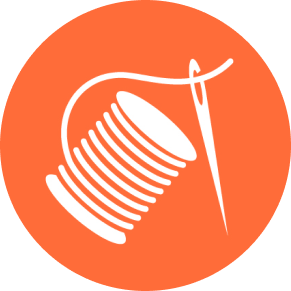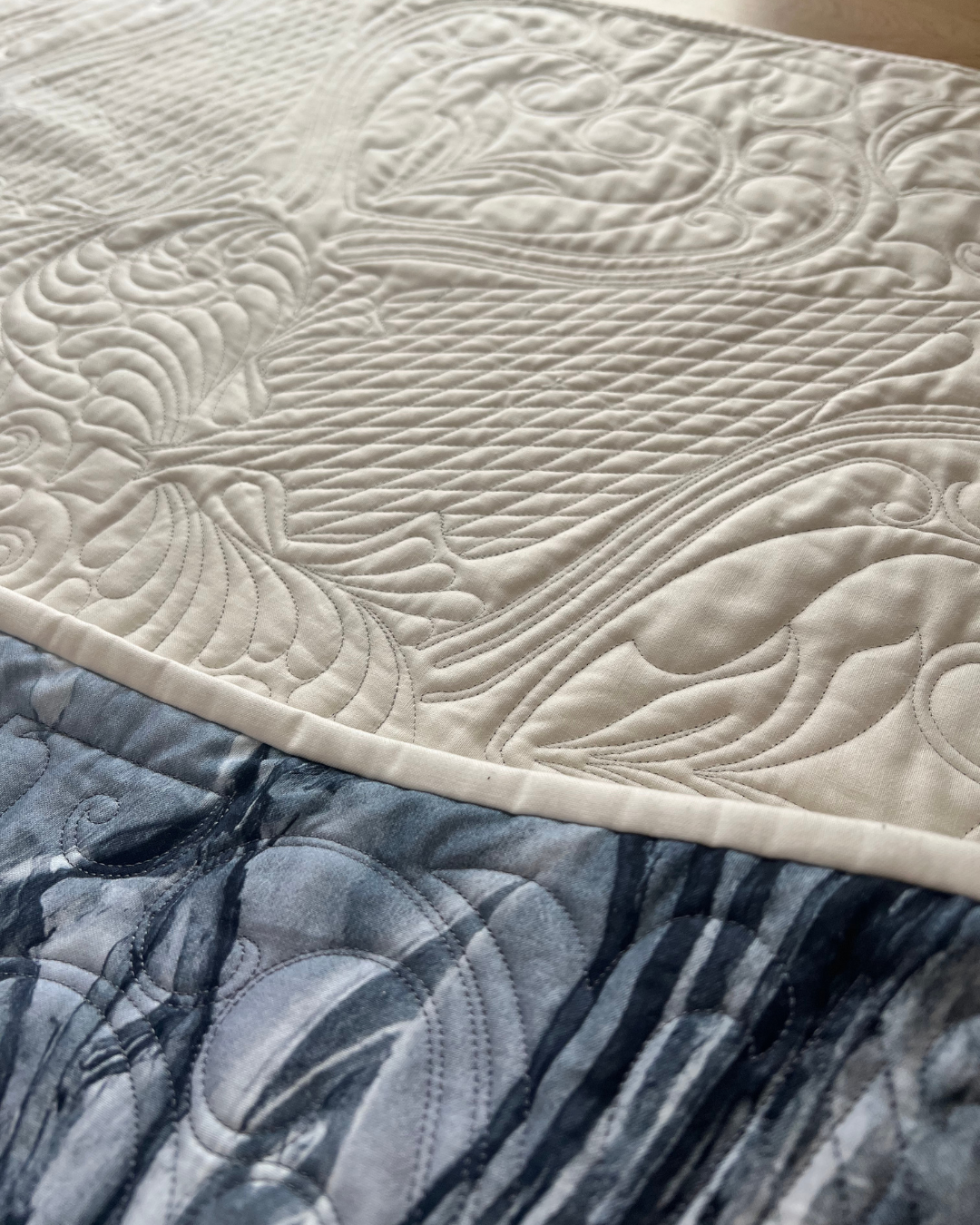Craftwright Quilts highly recommends using wideback fabrics for your quilts, whether those available through Craftwright Quilts directly, or through your local quilt shop or online vendor. Using wideback fabric for your quilt not only helps ensure a successful longarm quilting experience, but also benefits the look and feel of your overall quilt.
Here are some of the key advantages to using wideback fabrics:
Seamless Backing: Wideback fabric is typically 108 inches wide, which often eliminates the need for piecing together standard-width fabric to create a large enough piece for the back of a quilt. This results in a seamless back, which is particularly attractive on quilts where the stitching pattern is a prominent feature. In other words, if you are investing in longarm quilting, using a wideback ensures you maximize the impact of that investment.
Time-Saving: Since you don’t need to piece together multiple fabric sections, you save a significant amount of time in the preparation phase of your quilt. This means you can move on to the quilting process more quickly. Also, by using one of the widebacks available through Craftwright Quilts you decrease the cost of your backing and the shipping costs of your quilt to our shop.
Less Bulk: Without the extra seams from pieced backs, wideback fabric makes the finished quilt lie flatter and drape better. This is especially important for quilts that will be displayed or used in competitions.
Reduced Fabric Wastage: Piecing together smaller widths of fabric to make a quilt back can lead to more waste due to the extra fabric at the seams and the trimming needed to create straight edges. With wideback fabric, you cut exactly what you need.
Consistency in Color and Pattern: When you use a single wideback fabric, you ensure that the color, pattern, and dye lot are consistent across the entire back of the quilt. With pieced backs, there’s always a risk of slight variations between different bolts of fabric.
Strength and Durability: Seams can be the weakest point in a fabric piece, especially if the quilt is going to be used and washed frequently. A seamless wideback fabric eliminates potential weak points, making your quilt more durable over time.
Quilting Efficiency: For those who utilize longarm quilting, widebacks lead to better quilting tension on the frame and an overall smoother quilting result.
Economical: Although wideback fabric might have a higher per-yard cost than standard fabric, you often need less yardage since there’s no need to purchase extra to account for the overlap and seams. This can make it more cost-effective in the long run, particularly if you use one of Craftwright Quilts available designs.
Aesthetic Variety: Wideback fabrics come in a range of colors and patterns, some of which are specifically designed to complement quilt tops, offering an aesthetic that may not be available in narrower fabrics.
Enhanced Drape and Feel: A quilt back without seams is often softer and more pliable, which can enhance the overall feel and drape of the completed quilt.
Easier Binding: When attaching the binding, it’s simpler to work with a seamless quilt back, as you don’t have to worry about bulky seams or uneven areas where the backing pieces join.
Craftwright Quilts’ available designs can be found here.
If you do choose to prepare your own backing rather than use a wideback, there are tips and tricks for maximizing the success and final look of your quilt when using a pieced packing:
Calculate Your Backing Size: First, ensure your backing is at least 5 inches larger than your quilt top on all sides. This extra fabric is necessary for the longarm quilting process. If your backing does not have this extra width and length, then Craftwright Quilts will not be able to successfully longarm quilt your project.
Design Your Backing: Decide on a pattern or layout for your pieced backing. You can use large leftover blocks, strips, or even create a patchwork design. A simple option is to cut two large pieces of fabric and insert a contrasting strip or pieced column down the center. This inset should be horizontal, rather than vertical, to ensure we can keep your seams straight during the longarm quilting process. Vertical seams are difficult to work with on longarm quilting frames, so we strongly encourage using horizontal seams, where possible, to create your pieced backing.
Consider the Quilt Front: If your quilt top is very busy, you might want a simpler backing. Conversely, if your quilt top is simple, a more elaborate backing can add interest. In addition, if you want to increase the coziness of the quilt, using a backing like minky or Cuddle fabric is ideal and quilts beautifully.
Seam Allowances: Use a 1/2-inch seam allowance for piecing the backing to give it more stability, especially since the backing will be tugged and pulled during the quilting process.
Press Seams Open: To reduce bulk, press all seams open. This is particularly important for the longarm process where we will be quilting over the seams.
Balance the Piecing: Distribute the piecing and colors evenly across the backing so that the final product hangs and drapes evenly. We would also recommend minimizing the number of pieces to decrease the possibility of seams that become askew through the longarm quilting process.
Secure Loose Ends: Make sure to secure all piecing by backstitching at the beginning and end of seams, as the backing will undergo some stress during the quilting process.
Square the Backing: After piecing, ensure the backing is square and lies flat to avoid puckers and tucks when it’s quilted. The squaring process is easier if you tear your fabric, rather than cut it, before piecing.
Consider the Direction of the Fabric: If you are using fabrics with a directional print, make sure that the direction of the print matches up with your piecing. Please also let Craftwright Quilts know if there is a particular direction to your backing and how it should align with the quilt top.
Remove Selvedges: Before sewing your pieces together, remove the selvedges as they can shrink differently than the rest of the fabric, causing puckering.
Fabric Grain: Try to keep the fabric grain consistent when piecing the backing. This will help keep the backing stable and prevent distortion.
Think About the Quilting: Consider how the backing will interact with the quilting design. If the quilting is dense or intricate, a busy backing might hide this work. But if you have invested in a custom quilting design and want to ensure that it isn’t lost in the print, then using a solid backing, whether cotton or minky, both of which highlight quilting beautifully.
Testing Colorfastness: If you’re using very dark or bright fabrics, test for colorfastness to avoid dye transfer during washing. Also, if you prewash the fabrics in your quilt top you should also prewash your backing.
Use Quality Thread: Use good quality thread for piecing the backing to ensure the seams are strong and will hold up over time.
Check for Errors: Lay out the finished backing and inspect it for any piecing errors or puckers before attaching it to the quilt.
Document Your Work: If you’re making a pieced backing that’s particularly creative or complex, take a photo before it’s all covered up by the quilt top. This can be part of the documentation for your quilt.
By following these tips, you can create a quilt backing that is not only functional but also adds to the overall beauty of your quilt. Remember, the back of the quilt is like a canvas for additional creativity, so don’t be afraid to experiment and have fun with it! If you have any questions or concerns regarding whether your pieced backing will be successful for longarm quilting, Craftwright Quilts will happily provide a free review and consultation.


